Rethinking Excellence
Measuring impact is not just important to help educators to continuously improve outcomes for students, it should also be used as a measure of school quality. In Alexander Astin’s book, Assessment for Excellence, he explains how many measures of excellence look at the resources of a school, it’s reputation, or it’s outcomes. In particular he says that determining excellence based on outcomes is not useful because outcomes are highly related to inputs.
Astin argues against using outcome data, reputation, and resources as models for excellence and suggests that we should measure a school’s excellence based on the impact it had on students.
In other words, rather than measuring success simply based on a school’s outcomes, look at how much impact the school had on a group of students over time.
Excellence should be based on the impact that a college makes, or how much students learn, not just their outcomes. Think about a college with a strong reputation. Then consider which students are typically admitted to that college. If the incoming freshman have high achievement levels it's not a surprise that the college also has high achievement levels.

The image above explains the difference ways to use data to measure excellence and why measuring impact is the best way to determine excellence.


